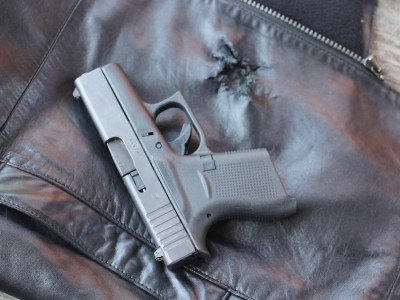
The GLOCK 43 was good for one shot. We expected it to jam in the lining of the coats, but it locked up when it couldn’t clear the spent case.
I have heard stories about shooting from the pocket without drawing the gun first–anecdotes from people with first-hand experience as well as the “I know a guy who has a friend who tried it” variety. I became interested in seeing what the real-world applications of this method might be along with what limitations this technique would impose.
Safety First
Not wanting to leave the range with either a hole that I didn’t bring with me, scorched flesh or some other embarrassing injury, we decided that a few safety protocols would be necessary for this operation to succeed. First of all, the participants in this exercise reviewed Col. Cooper’s 4 Rules of Gun Safety. Next we employed some pre-tests using safety gear to determine the feasibility of this technique before jumping in with both feet. Finally, we agreed on each person’s on-range roles and responsibilities in regard to the loading and handling of the weapons involved in this test.
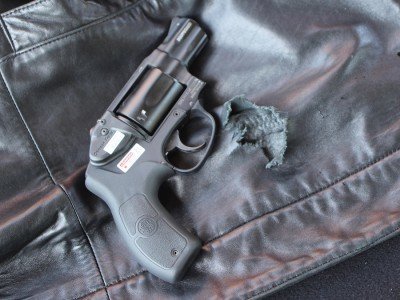
The perfect pocket pistol? At least for firing from inside a coat. This Smith has a laser, too–though it doesn’t do you much good inside the pocket.
Weapon Selection
There are a vast number of weapons that will fit in your pocket. I wanted to select two guns that (to me) represent modern self-defense handguns with a reputation for reliability. Some concepts were rejected out of hand as they seemed to present a high probability of failure. A couple of examples of these were exposed hammer revolvers and pistols with external safety controls.
What we selected for the test was the Smith & Wesson M&P Bodyguard .38 and the new Glock 43 in 9 mm. We believe these two types of guns clearly represented the highest probability of success with this method of shooting, even as we acknowledge that there are numerous brands and models that would represent an equally fine choice. These also happened to be readily available the day of testing.
I think equally important as what we selected in firearms, is our selection of ammunition for this test. This test needed to be performed with self-defense ammunition. To that end we selected Hornady Critical Duty 9mm for the Glock. For the Smith & Wesson we selected Remington Golden Saber, mostly–and several other JHPs we had on hand.
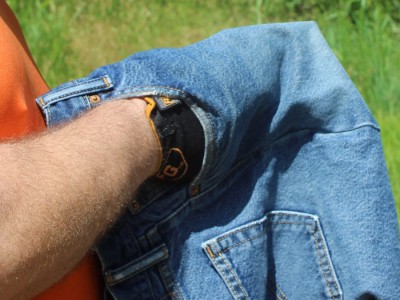
Safety? Within reason. A gloved hand inside a tight pocket. As it turned out, there was no heat to speak of.
Proof of concept
Having never done this before, I needed a baseline to assure me that I was not going to injure myself. I also wanted verification that the guns were not going to fail to function no matter how I positioned them. The method that I employed to do this was to first, glove up. This would offer me some protection on my hands and allow me to see if there was any powder burn or pressure issues that would prohibit safe functioning during the test. The next portion was to simply fire the guns through the pocket of an old pair of blue jeans. This would allow me to control how the gun was positioned and keep the action from becoming caught in the fabric.
It was quickly evident to me that the guns would function and there was no heat or pressure issues that I experienced while firing the guns. The one issue that I quickly noticed is that it is very difficult to be aware of your muzzle when firing from a garment. I’m sure some of you are having a forehead palm moment, but hear me out! This is more than just not being able to see the muzzle. You are dealing with clothing that will not allow a visual confirmation. It is definitely a new sensory input when attempting to manipulate the gun safely.
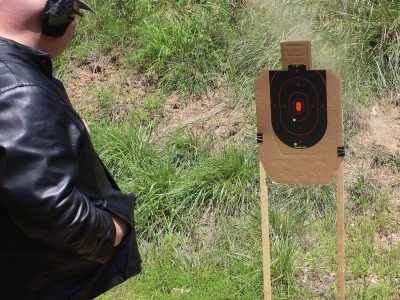
We shot from distances ranging from contact to 15 feet. The closer you are, the better it works. Not a surprise.
Trust but Verify
I think it was President Reagan who said in reference to the Soviet Union, “We should trust but verify.” My plan was to do just the same thing with these two little pocket pistols. So, the initial distance chosen was 9 feet. My first garment was a leather dress jacket. I felt that it was important to have a garment that was not just nylon or cotton. Also, my wife hates this particular jacket and forbid me to ever wear it in public with her. From one pocket I fired two rounds from the revolver and from the other pocket two rounds from the pistol. Functioning was flawless for both guns. However accuracy, at best, was just acceptable.
Next, I moved to 15 feet and switched to a nylon jacket. I also reversed the guns in my pockets. First, I fired two rounds from the little Glock and then two rounds from the M&P. As before, the issue was not functioning but rather accuracy. I got three of the four rounds on target somewhere but most would not have been highly effective hits.
The next test was performed by my colleague David Higginbotham, Editor-in-Chief of Guns America. This was what we called the Real-World Test. Starting at almost contact distance, David first fired from inside the pocket while retreating, then retrieving the gun for aimed fire as more distance was created. The little Smith & Wesson performed flawlessly and accuracy was well worthy of embracing this technique as a close-quarters self-defense tool. The only thing left was to replicate the test with the popular Glock 43. We began the test and the first shot quickly struck the target center-mass but then the gun fell silent. The gun was retrieved to reveal a very interesting level 2 malfunction. This would have required removing the magazine, racking the gun, reinserting the magazine and cycling the slide to get back in the fight.
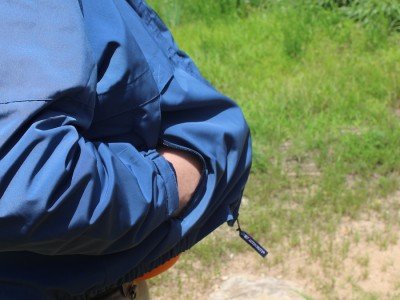
The nylon coat offered nice concealment, and the gun poked through the hole easily for better follow-up shots.
What worked and what did not
This is one of the few recaps I’ve done where there’s no ambiguity. Only the revolver with no exposed hammer is going to deliver 100% reliability in shooting from your jacket pocket. In the words of Walt Rauch, “This is a bad breath technique” (meaning that you would have to be close enough to smell the perp’s breath for it to be effective). I would be reluctant to rely on this technique at even a mere 9 feet. One detail worth noting is that I consistently had more accuracy from the revolver regardless of distance. I think this is because the grip is just more intuitive for this unique style of shooting.
Limits of shooting from the pocket
The limits became brighter and brighter as we fired round after round. Shooting from the pocket requires you to be indexed on a single target. I would not recommend this with multiple targets. Your clothing must have enough room to allow you to operate the gun. Most people will find distance to be uncomfortably close in order to be assured of well-placed hits.
And don’t forget that carrying your gun in your coat pocket, free from a holster (so it can be used in this manner), isn’t always easy or advisable. It is an element of staging your gun that requires planning and caution.
Final thoughts and advice
To use this technique for self-defense you must practice! This is not for beginners and your choice of weapon is critical. But this is a valid self-defense method of shooting within a narrow set of circumstances. The one facet of this shooting-through technique that we did not test is shooting from a complete off-body platform such as a briefcase or man purse of some kind. I would be interested in revisiting that at another time.